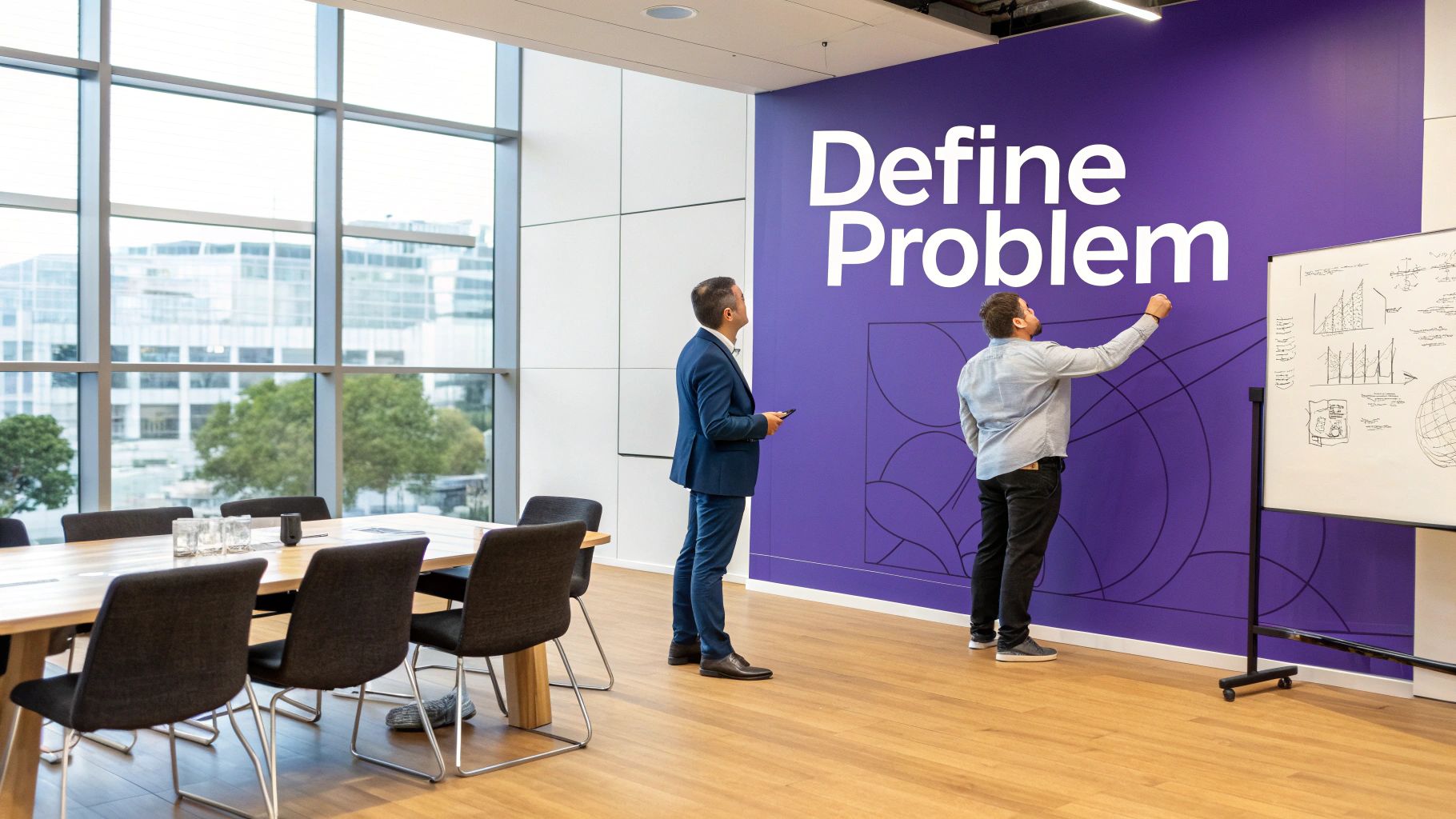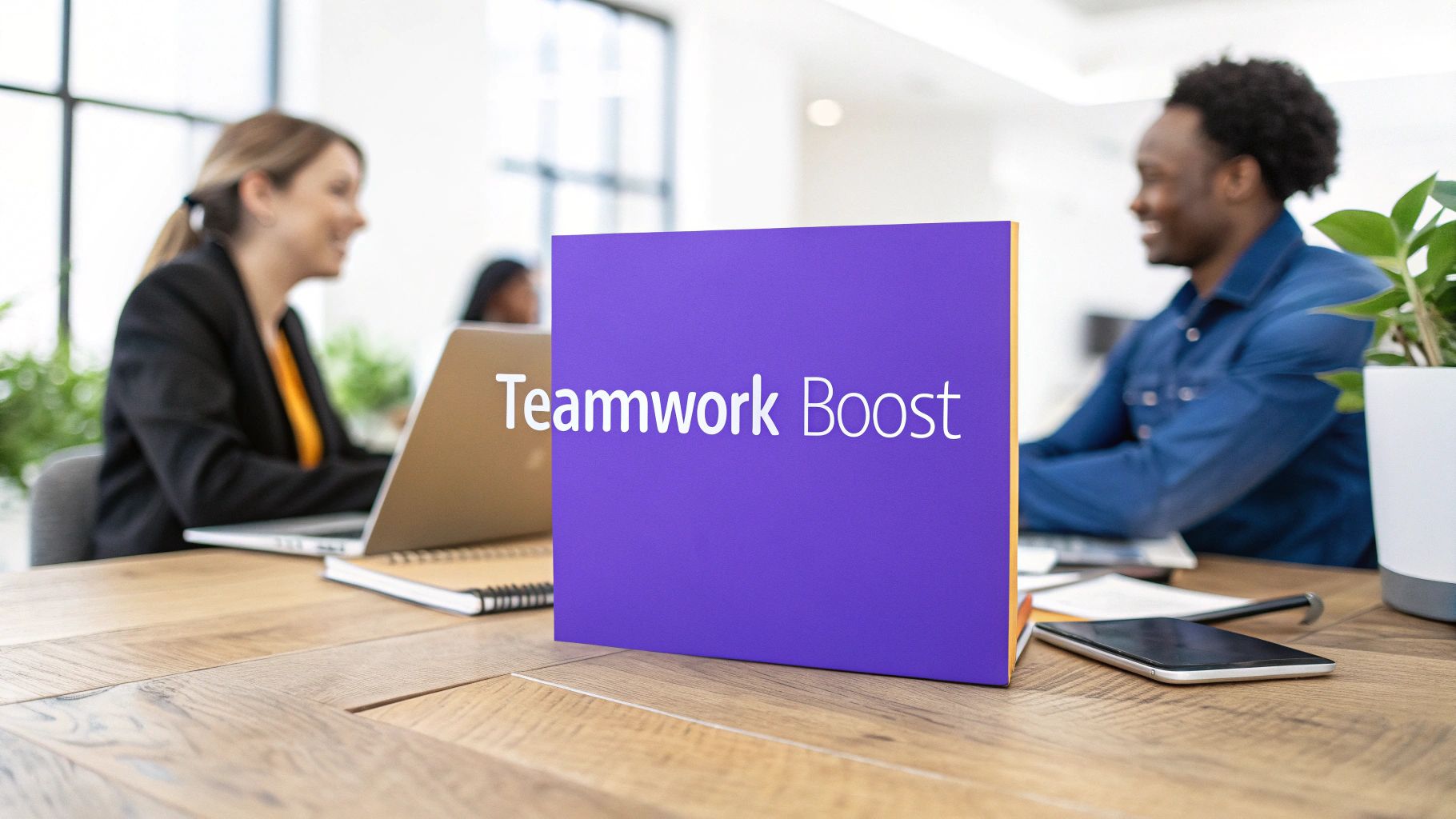The Hidden Power of Collaborative Problem Solving

Today’s teams often face complex challenges. These challenges demand more than just individual skill. This need has led to a greater focus on collaborative problem solving. This approach uses the combined knowledge and skills of a group.
It goes beyond typical brainstorming. It involves structured steps and builds a shared understanding within the team. This not only solves the immediate problem but also helps find and address the root causes.
The result? More effective, longer-lasting solutions that the whole team supports.
Why Collaboration Trumps Individual Effort
Collaborative problem-solving makes sure everyone’s voice is heard. This creates a sense of ownership among team members. This inclusive environment is key for gathering different perspectives.
For example, a team member with logistics experience might spot implementation issues that others miss. Working together also sparks more creative and innovative solutions. This happens because individuals combine their strengths. This can be especially helpful for remote teams. A structured approach can help these teams connect and brainstorm productively. Bulby is one platform that offers this kind of structured approach.
Collaborative problem-solving (CPS) is increasingly recognized as an essential skill. A study of 1,000 participants on Amazon Mechanical Turk highlighted the link between CPS skills and positive outcomes. The study measured collaborative effectiveness using factors like “number of changes” and “score change”.
Effective collaboration often involved team members revising their initial ideas after working together. This highlights the importance of being open to feedback and change. Learn more about this study here.
The Pillars of Effective Collaborative Problem Solving
Several key elements contribute to successful collaborative problem solving. Psychological safety is one such element. It creates a space where people feel comfortable sharing ideas without fear of judgment.
This leads to more open and productive discussions. But psychological safety is just the starting point.
Structured processes are also critical. These provide a clear path for the team. They help everyone stay focused and avoid unproductive conversations. These processes usually involve defining the problem, generating solutions, evaluating options, and implementing the chosen solution.
Finally, effective communication is essential throughout the process. Clear communication keeps everyone informed and prevents misunderstandings. It also helps ensure a smooth implementation of the chosen solution. This requires active listening, respectful dialogue, and a commitment to transparency. By following these principles, teams can unlock the real power of collaborative problem solving and achieve great things.
Step 1: Define The Problem That Actually Matters

Many teams fall into the trap of solving the wrong problems. They get bogged down in surface-level issues without ever addressing the root causes. It’s like treating the symptoms of a disease without understanding the underlying illness. This section explores the critical first step in collaborative problem solving: defining the problem that truly matters. Investing time upfront in this phase yields significant returns, preventing wasted effort on ineffective solutions.
Distinguishing Symptoms From Root Causes
Successful teams recognize the crucial difference between symptoms and root causes. A symptom is an observable effect, while a root cause is the underlying reason for that effect. Low employee morale, for example, is a symptom. It could stem from various root causes such as a lack of recognition, poor communication, or limited growth opportunities. Simply addressing the symptom of low morale might offer temporary relief, but the problem will likely reappear.
This highlights the importance of collaborative diagnosis. Teams must work together to uncover the underlying issues driving the symptoms they observe. A shared understanding of the true problem sets the stage for effective solutions.
Frameworks For Inclusive Problem Framing
So, how can teams effectively frame problems collaboratively? Several helpful techniques exist. The “5 Whys” method, for instance, involves repeatedly asking “why” to delve deeper into the issue, peeling back the layers to reach the core problem. Another useful tool is the fishbone diagram. This visual method maps out potential causes, encouraging diverse perspectives and more in-depth exploration.
These frameworks create inclusive problem-solving sessions. They ensure that all team members have a voice and that valuable insights aren’t missed. This leads to a richer, more comprehensive understanding of the problem, allowing teams to focus their efforts on the right areas.
This structured approach isn’t limited to businesses. The Des Moines Public Schools (DMPS) utilize a collaborative problem-solving process as part of their Multi-Tiered System of Supports (MTSS). This process uses existing data, analyzes potential causes, and develops a theory of action to address the core issue. In Step 1, they define the problem by comparing desired outcomes with current data, using tools like FAST Analysis.
Crafting Effective Problem Statements
Once the root cause is identified, crafting a clear and concise problem statement is essential. This statement should be specific and measurable, focusing on the problem itself, not the solution. For example, instead of saying “We need better marketing materials,” a more effective problem statement would be, “Our current marketing materials are not attracting our target audience, leading to a 15% decline in leads.”
This level of clarity is crucial. It ensures that the entire team understands the problem and develops solutions that directly address the core challenge. It’s vital that all team members agree on this shared definition of the problem. This alignment prevents misunderstandings and allows the team to move forward with a unified purpose.
Step 2: Uncover What Stakeholders Actually Care About

After defining the problem, understanding your stakeholders is crucial for collaborative problem solving. This goes beyond superficial statements. It means uncovering their underlying interests, concerns, and motivations. Skipping this step is common, but it’s essential for getting genuine buy-in. It also ensures your solutions address real needs, not just perceived symptoms.
Why Understanding Stakeholder Interests Is Critical
Understanding stakeholder interests is the foundation of effective solutions. Without it, solutions might look good theoretically but fail in practice due to conflicting priorities. When you identify shared interests, you build momentum and fuel collaboration. Addressing conflicting priorities early on prevents future roadblocks. This also creates a more transparent and trusting environment.
Imagine a team trying to improve customer service. One stakeholder might prioritize speed, while another values personalized attention. A third might focus on cost-effectiveness. If these interests aren’t addressed, the solution might be a weak compromise that satisfies no one. Uncovering what matters to each stakeholder is essential for solutions that truly work and last. A structured approach to collaborative problem solving (CPS) is outlined in the Collaborative Problem-Solving Handbook. This approach, which emphasizes identifying stakeholder interests, ensures everyone has a voice. Learn more about structured approaches to collaborative problem solving.
Creating Psychological Safety for Honest Sharing
One of the biggest hurdles to understanding stakeholder interests is creating an environment of open communication. People need to feel comfortable sharing their honest thoughts and concerns. This requires psychological safety, where individuals can express themselves without fear of judgment or negative consequences.
Here are some practical methods for fostering psychological safety:
- Structured Interviews: These provide a dedicated space for individual stakeholders to share their perspectives.
- Anonymous Feedback Mechanisms: These are especially helpful for sensitive topics, allowing for candid input without fear of retribution.
- Active Listening and Validation: Showing that you truly hear and value stakeholder perspectives builds trust and encourages open communication.
To help visualize these methods and their applications, consider the following table:
Stakeholder Interest Discovery Methods That Actually Work: A comparison of proven approaches to uncover what stakeholders truly care about, with real-world applications.
| Method | Best Used When | Benefits | Potential Challenges |
|---|---|---|---|
| Structured Interviews | Seeking in-depth understanding from individual stakeholders | Provides rich qualitative data, allows for follow-up questions | Can be time-consuming, requires skilled interviewers |
| Anonymous Feedback Mechanisms | Addressing sensitive topics or when there’s a lack of trust | Encourages candid feedback, protects individuals from potential repercussions | Difficult to clarify responses, may not capture the full context |
| Active Listening & Validation | Building rapport and fostering trust | Creates a safe space for open dialogue, strengthens relationships | Requires active engagement and genuine empathy from the listener |
This table highlights how each method can be used to gather valuable insights from stakeholders, while also acknowledging the potential challenges of each approach. Choosing the right method depends on the specific context and the desired level of depth and anonymity.
Practical Techniques for Uncovering Hidden Needs
Beyond creating psychological safety, specific techniques can help uncover deeper stakeholder motivations.
- Asking “Why” Questions: Repeatedly asking “why” helps uncover the underlying reasons behind stated positions, revealing hidden needs and priorities.
- Empathy Mapping: This technique helps teams step into the shoes of their stakeholders. It helps you consider their thoughts, feelings, and motivations related to the problem.
- Observational Research: Observing stakeholders in their natural environment can provide valuable insights into their unspoken needs and challenges.
By combining these techniques, teams can create a comprehensive understanding of stakeholder interests. This sets the stage for truly collaborative problem solving. This crucial step ensures that solutions address the problem and align with the values and priorities of those affected. Tools like Bulby can enhance this process. Bulby provides a structured platform for remote teams to gather and analyze stakeholder input, fostering more insightful collaboration. This collaborative approach leads to stronger, more impactful solutions.
Step 3: Generate Solutions That Break New Ground

Teams often settle for the first workable solution. This can cause them to miss out on truly innovative breakthroughs. This crucial step in collaborative problem solving is about fostering creative thinking. It means going beyond the obvious and exploring uncharted territories. By creating a judgment-free atmosphere, teams can unlock their full potential for generating novel solutions.
Structured Brainstorming for Collaborative Settings
Structured brainstorming provides a framework for effective idea generation. This is different from free-form brainstorming, which can be less effective. Free-form brainstorming can be dominated by louder voices or pre-existing biases.
Instead, use techniques specifically designed for collaboration.
- The “Round Robin” technique ensures every team member contributes equally. This prevents dominant personalities from taking over.
- “Brainwriting” involves individuals writing down their ideas before sharing. This encourages independent thinking and a wider range of perspectives.
These methods create a more balanced and inclusive brainstorming session. You might be interested in: How to master creative problem solving for breakthrough innovation.
Leveraging Digital Tools for Enhanced Idea Generation
Technology plays a significant role in collaborative problem solving. Digital brainstorming tools like Bulby enhance idea generation. They offer features like:
- Anonymous idea submission
- Real-time voting
- Visual organization of concepts
This allows for more diverse participation, especially for remote teams. These tools also help bridge the gap between different personalities and working styles. Teams can effectively capture insights from both synchronous sessions and asynchronous contributions, maximizing the potential for innovative solutions.
Facilitation Approaches for Diverse Teams
Tools alone aren’t enough. Effective facilitation is essential for guiding diverse teams. A skilled facilitator creates psychological safety. This allows individuals to share unconventional ideas without fear of judgment. It means fostering constructive feedback. Team members can build upon each other’s ideas, rather than simply criticizing them.
For example, asking specific questions encourages collaborative exploration. Questions like “How might we expand on this idea?” or “What are the potential benefits of this approach?” can push teams beyond their initial assumptions.
Building Upon Ideas and Capturing Insights
This step also emphasizes capturing and building upon ideas. Visual aids like mind maps or digital whiteboards help visualize connections between concepts. This visual approach helps teams see the bigger picture and identify potential areas for innovation.
Documenting the brainstorming process is also important. This includes both successful and unsuccessful ideas. This documentation becomes a valuable resource for future problem-solving. It can serve as a knowledge base for future projects and help teams avoid repeating past mistakes. By combining structured techniques, digital tools, and skilled facilitation, teams can generate truly groundbreaking solutions.
Step 4: Evaluate Options Without Political Theater
Collaboration is key to problem-solving, but the evaluation stage is often where things go wrong. Instead of objective analysis, teams can get caught up in unproductive politics. This section explores how to avoid these pitfalls and keep the focus on finding the best solution. It involves setting clear criteria and facilitating productive discussions, even when there are disagreements.
Developing Evaluation Criteria Tied to Stakeholder Interests
Good evaluation begins with well-defined criteria. These criteria should directly reflect the stakeholder interests identified in Step 2.
For example, if a key stakeholder prioritizes cost-effectiveness, then “budget impact” should be a main evaluation criterion. If another stakeholder values user experience, then “ease of use” should be assessed. This ensures the chosen solution addresses stakeholders’ priorities.
Using Decision Matrices for Balanced Evaluation
Decision matrices provide a structured approach to evaluating multiple options against various criteria. A simple matrix might list each potential solution as a row, with the evaluation criteria as columns. Each cell then contains a score for how well that solution meets that specific criterion. This visual format helps teams compare options objectively.
Facilitating Discussions and Managing Disagreements
Even with clear criteria and decision matrices, disagreements are bound to happen. A skilled facilitator can guide teams through these disagreements constructively. This involves promoting respectful dialogue, active listening, and focusing on common goals. Techniques like weighted voting can help break deadlocks while acknowledging the varying importance of different criteria. For more insights on potential obstacles, check out our guide on cognitive biases in decision-making.
Counteracting Common Evaluation Pitfalls
Several common biases can hinder objective evaluation. Groupthink, where dissenting opinions are suppressed for group harmony, can lead to poor decisions. Status deference, where opinions of senior team members are overvalued, can silence valuable perspectives. Recency bias, where recent information overshadows earlier insights, can also lead teams astray. Recognizing these pitfalls is the first step to minimizing their effect. For instance, techniques like anonymous feedback can help counteract status deference.
Interestingly, the quality of collaboration, not the speed or number of actions, seems crucial for success. The 2015 OECD PISA study on collaborative problem-solving found that successful participants took more time and performed fewer actions than their less successful (but faster) counterparts. You can discover more insights about this research here. This highlights the importance of thoughtful evaluation, even if it takes more time.
By addressing these points, teams can make sure the best solutions win based on merit, not who proposed them or who speaks the loudest. Tools like Bulby can also be helpful at this stage. They offer a structured platform to evaluate options and record the decision-making process, improving transparency and objectivity. Read also: How to master creative problem solving for breakthrough innovation.
Step 5: Implement Solutions People Actually Support
Implementation is often where even the best-laid plans can go astray. It’s not simply about executing a pre-defined strategy; it’s about bringing your team along for the ride and fostering a sense of shared ownership. This step focuses on turning a chosen solution into concrete action. This requires clear accountability and a commitment to the original goals.
Developing Actionable Implementation Plans
A well-defined implementation plan is crucial. This plan should delegate responsibilities fairly, leveraging individual team members’ strengths and preferences. For example, someone with strong project management skills might oversee task assignments, while a team member with excellent communication skills could manage stakeholder updates.
Imagine a sports team: each player has a unique role and skill set that contributes to the overall game plan. This maximizes individual strengths while driving collective success. These plans should also be adaptable, allowing for changes as the project progresses.
Establishing Clear Communication Protocols
Excessive meetings can be counterproductive, draining team energy and slowing progress. Instead, establish clear communication protocols to keep everyone aligned without unnecessary overhead. A project management platform like Bulby can centralize updates, feedback, and decisions, minimizing email clutter and ensuring everyone accesses the same information.
Regular, short check-in meetings can be more efficient than long, infrequent ones. These quick check-ins help maintain momentum and address potential roadblocks as they emerge, keeping the project on course.
Tracking Progress and Identifying Potential Issues
Implementing a solution can be compared to navigating a ship. You need tools to track your location and anticipate potential challenges. Progress tracking systems provide this essential navigation. Tools like Bulby, with its integrated progress tracking features, enable teams to monitor milestones and identify potential roadblocks early on.
This shared visibility is especially crucial for collaborative problem-solving. When everyone has access to the project’s status, they are more inclined to take ownership and contribute to solutions. It’s like having a shared map to guide the team towards its objective.
Managing Resistance and Scope Changes
Change isn’t always readily embraced. Resistance to new solutions is expected. Address this proactively with open communication and empathy. Involving resistant team members in the implementation process can foster ownership and alleviate concerns.
Scope changes are also inevitable in most projects. A flexible implementation plan allows for adjustments without derailing the entire initiative. Collaborative decision-making ensures these changes align with the original intent of the solution.
Ensuring the Solution’s Core Intent Remains Intact
Throughout implementation, regularly revisit the initial problem definition and stakeholder needs. This ensures that the solution, even with inevitable changes, stays true to its purpose. It reinforces the team’s “why”—the shared motivation behind the project.
This shared understanding strengthens commitment and helps navigate implementation hurdles. By actively supporting the solution throughout its implementation, teams pave the way for sustainable and impactful outcomes.
Step 6: Measure What Actually Matters
The collaborative process doesn’t end with implementing a solution. It continues with careful evaluation. This stage involves setting clear metrics, gathering honest feedback, and building a culture of continuous improvement. This ensures your team not only solves the immediate problem but also learns and grows from the experience.
Establishing Meaningful Metrics
Successful collaborative problem solving depends on measurable results. These metrics should directly relate to the original problem and stakeholder needs. For example, if the initial problem involved low customer satisfaction, a relevant metric would be an increase in positive customer reviews. This direct link keeps the team focused on what truly matters.
Also, consider using both quantitative and qualitative data. Numerical data like sales figures or website traffic offers objective measures of success. Qualitative feedback from surveys or interviews provides valuable insight into the reasons behind the numbers. This balance creates a more complete understanding of your solution’s impact.
Gathering Honest Feedback: Process and Results
Feedback is essential for improvement. Create systems for gathering honest feedback on both the solution’s effectiveness and the collaborative process. Anonymous surveys can encourage candid responses, especially for sensitive topics. Regular check-in meetings provide an open forum for discussion and real-time feedback. This creates a continuous feedback loop, allowing for adjustments during implementation.
In studying collaborative problem-solving skills, researchers often use human-to-human interaction models to understand real-world teamwork. One study with 434 participants working in pairs used a multidimensional model to analyze individual skills and group performance. The study found a strong link between successful task completion and higher average abilities within the group. Learn more about this research here. This highlights the importance of assessing both individual and group dynamics.
Documenting Lessons Learned and Best Practices
Document lessons learned and best practices throughout the process. A shared platform, like Bulby, creates a central location for storing this information. This knowledge base becomes a valuable resource for future problem-solving, preventing repeated mistakes and helping teams find effective solutions faster.
Fostering a Culture of Continuous Improvement
Successful teams balance accountability with celebrating progress. Recognizing individual and team achievements reinforces positive collaborative behaviors. This creates a positive cycle, encouraging continued engagement and fostering a culture of continuous improvement. This makes collaborative problem-solving an ongoing process, not just a one-time event. Regular reflection on past projects strengthens this commitment to growth and learning.
To understand the effectiveness of your collaborative problem-solving process, it’s important to look beyond traditional Key Performance Indicators (KPIs). The following table outlines metrics that provide a more complete picture by focusing on both the quality of the process and the impact of the solution.
Metrics That Reveal Collaborative Problem Solving Success
Essential measures that capture both process quality and solution effectiveness beyond traditional KPIs
| Metric Category | Specific Measures | Collection Methods | Interpretation Guidance |
|---|---|---|---|
| Solution Effectiveness | Increased sales, improved customer satisfaction, reduced error rates | Sales data, customer surveys, error tracking systems | Compare results against pre-defined targets |
| Process Quality | Team member satisfaction, level of engagement, effective communication | Team surveys, meeting observations, communication analysis tools like Bulby | Look for trends and areas for improvement |
| Innovation | Number of new ideas generated, implementation of creative solutions | Idea tracking tools (like Bulby), post-project reviews | Evaluate the novelty and impact of implemented solutions |
| Efficiency | Time taken to reach a solution, resources used | Project management software, time tracking tools | Assess the efficiency of the collaborative process |
By using these diverse metrics, teams can truly measure what matters in collaborative problem-solving. This comprehensive approach ensures sustainable success and continuous improvement, leading to better results and stronger teams.
Building a Culture Where Collaborative Solving Thrives
Individual collaborative wins are great, but weaving these practices into your company’s core creates lasting success. This means shifting from occasional collaborative problem-solving to making it the standard approach. This section explores how leaders can drive this change, creating environments where everyone contributes their best thinking.
Overcoming Entrenched Barriers
Many organizations face obstacles to true collaboration. Silo mentalities, where departments work in isolation, limit sharing and stifle innovation. Competitive incentives, which reward individual accomplishments over teamwork, discourage cooperation. Also, artificial time pressures often prioritize speed over thoughtful collaboration.
To address these challenges, leaders must actively encourage cross-functional teamwork, reward group accomplishments, and create realistic project timelines. This might involve restructuring teams, adjusting performance metrics, and implementing project management tools that support collaboration. For instance, platforms like Bulby can facilitate clear communication and efficient workflows, easing the pressure of deadlines.
Fostering a Culture of Psychological Safety
A cornerstone of successful collaborative problem-solving is psychological safety. This creates an atmosphere where people feel comfortable sharing ideas without fear of being judged. This encourages open communication and leads to more diverse perspectives, better brainstorming, and stronger solutions.
Creating psychological safety takes effort. Leaders must model vulnerability, actively seek different opinions, and respond to disagreements respectfully. This builds a culture where helpful feedback replaces criticism and learning from mistakes is valued over assigning blame. Learn more in our article about how to foster teamwork in remote teams.
Unlocking the Power of Diverse Thinking and Collective Intelligence
Diverse teams consistently outperform uniform groups in complex problem-solving. Different backgrounds and experiences lead to more creative solutions and better evaluation of options. This creates collective intelligence, where the group’s combined knowledge surpasses what any one individual could achieve.
Leaders can unlock this potential by building diverse teams and actively seeking different viewpoints during brainstorming and evaluation. Inclusive decision-making processes are also key. Tools like Bulby can facilitate anonymous idea sharing and live voting, ensuring everyone’s voice is heard, regardless of seniority or personality.
Practical Next Steps for Championing Collaborative Approaches
You don’t need a formal leadership role to champion collaborative problem-solving. Anyone can contribute by:
- Promoting open communication: Listen to colleagues’ ideas and offer constructive feedback.
- Facilitating inclusive meetings: Ensure everyone gets a chance to speak and all viewpoints are considered.
- Advocating for collaborative tools: Introduce platforms like Bulby to streamline workflows and improve communication.
- Celebrating collaborative successes: Highlight team achievements and the value of working together.
By embracing these practices, you can help create a culture where collaborative problem-solving is the norm, driving innovation and leading to more effective solutions. Supercharge your team’s collaborative problem-solving with Bulby, the brainstorming platform designed for remote teams. Learn more and try Bulby today.

